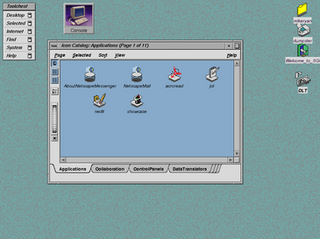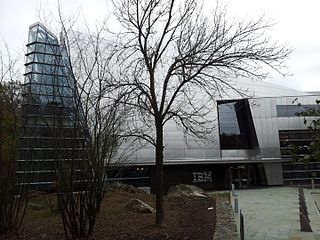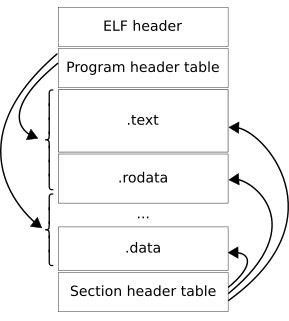
In computing, the Executable and Linkable Format, is a common standard file format for executable files, object code, shared libraries, and core dumps. First published in the specification for the application binary interface (ABI) of the Unix operating system version named System V Release 4 (SVR4), and later in the Tool Interface Standard, it was quickly accepted among different vendors of Unix systems. In 1999, it was chosen as the standard binary file format for Unix and Unix-like systems on x86 processors by the 86open project.
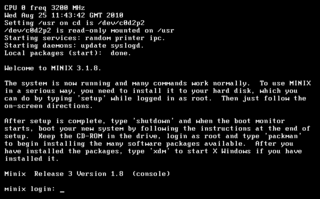
MINIX is a POSIX-compliant, Unix-like operating system based on a microkernel architecture.
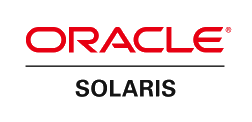
Solaris is a Unix operating system originally developed by Sun Microsystems. It superseded their earlier SunOS in 1993. In 2010, after the Sun acquisition by Oracle, it was renamed Oracle Solaris.

Hercules is a computer emulator allowing software written for IBM mainframe computers and for plug compatible mainframes to run on other types of computer hardware, notably on low-cost personal computers. Development started in 1999 by Roger Bowler, a mainframe systems programmer.
In computer architecture, 64-bit integers, memory addresses, or other data units are those that are 64 bits wide. Also, 64-bit CPU and ALU architectures are those that are based on registers, address buses, or data buses of that size. 64-bit microcomputers are computers in which 64-bit microprocessors are the norm. From the software perspective, 64-bit computing means the use of code with 64-bit virtual memory addresses. However, not all 64-bit instruction sets support full 64-bit virtual memory addresses; x86-64 and ARMv8, for example, support only 48 bits of virtual address, with the remaining 16 bits of the virtual address required to be all 0's or all 1's, and several 64-bit instruction sets support fewer than 64 bits of physical memory address.
SPIM is a MIPS processor simulator, designed to run assembly language code for this architecture. The program simulates R2000 and R3000 processors, and was written by James R. Larus while a professor at the University of Wisconsin–Madison. The MIPS machine language is often taught in college-level assembly courses, especially those using the textbook Computer Organization and Design: The Hardware/Software Interface by David A. Patterson and John L. Hennessy (ISBN 1-55860-428-6).
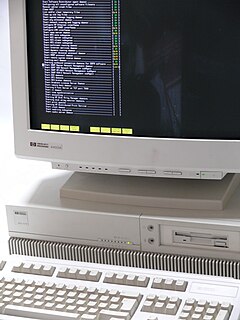
UNIX System V is one of the first commercial versions of the Unix operating system. It was originally developed by AT&T and first released in 1983. Four major versions of System V were released, numbered 1, 2, 3, and 4. System V Release 4 (SVR4) was commercially the most successful version, being the result of an effort, marketed as Unix System Unification, which solicited the collaboration of the major Unix vendors. It was the source of several common commercial Unix features. System V is sometimes abbreviated to SysV.

CRUX is a lightweight, x86-64-optimized Linux distribution targeted at experienced Linux users and delivered by a tar.gz-based package system with BSD-style initscripts. It is not based on any other Linux distribution. It also utilizes a ports system to install and upgrade applications.
A hypervisor or virtual machine monitor (VMM) is computer software, firmware or hardware that creates and runs virtual machines. A computer on which a hypervisor runs one or more virtual machines is called a host machine, and each virtual machine is called a guest machine. The hypervisor presents the guest operating systems with a virtual operating platform and manages the execution of the guest operating systems. Multiple instances of a variety of operating systems may share the virtualized hardware resources: for example, Linux, Windows, and macOS instances can all run on a single physical x86 machine. This contrasts with operating-system-level virtualization, where all instances must share a single kernel, though the guest operating systems can differ in user space, such as different Linux distributions with the same kernel.
In computing, para-virtualization is a virtualization technique that presents a software interface to the virtual machines which is similar, yet not identical to the underlying hardware–software interface.
QuickTransit is a cross-platform virtualization program developed by Transitive Corporation. It allows software compiled for one specific processor and operating system combination to be executed on a different processor and/or operating system architecture without source code or binary changes.
Project Trillian was an effort by an industry consortium to port the Linux kernel to the Itanium processor. The project started in May 1999 with the goal of releasing the distribution in time for the initial release of Itanium, then scheduled for early 2000. By the end of 1999, the project included Caldera Systems, CERN, Cygnus Solutions, Hewlett-Packard, IBM, Intel, Red Hat, SGI, SuSE, TurboLinux and VA Linux Systems. The project released the resulting code in February 2000. The code then became part of the Linux baseline kernel more than a year before the release of the first Itanium processor. The Trillian project was able to do this for two reasons:
ptrace is a system call found in Unix and several Unix-like operating systems. By using ptrace one process can control another, enabling the controller to inspect and manipulate the internal state of its target. ptrace is used by debuggers and other code-analysis tools, mostly as aids to software development.

libvirt is an open-source API, daemon and management tool for managing platform virtualization. It can be used to manage KVM, Xen, VMware ESXi, QEMU and other virtualization technologies. These APIs are widely used in the orchestration layer of hypervisors in the development of a cloud-based solution.
In computing, a system virtual machine is a virtual machine provides a complete system platform which supports the execution of a complete operating system (OS). These usually emulate an existing architecture, and are built with the purpose of either providing a platform to run programs where the real hardware is not available for use, or of having multiple instances of virtual machines leading to more efficient use of computing resources, both in terms of energy consumption and cost effectiveness, or both. A VM was originally defined by Popek and Goldberg as "an efficient, isolated duplicate of a real machine".


